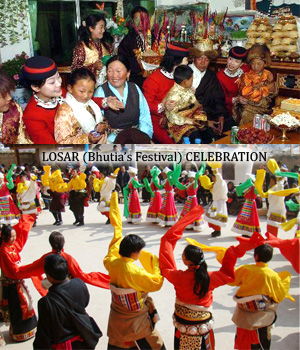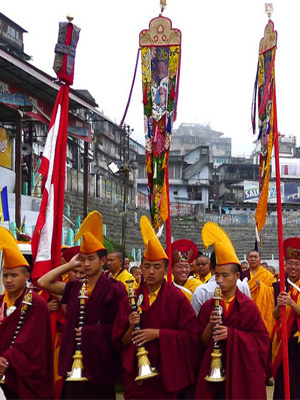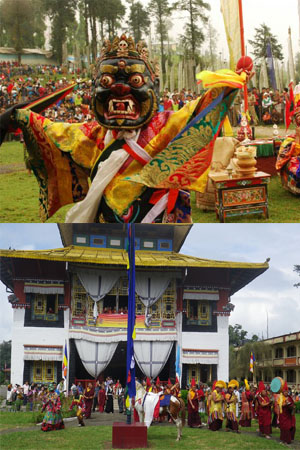Bhutias are warm hearted and simple people. The traditional attire of both male and female are called Bakhus. Though it is common sight to see the women folk attired in bakhus varying from traditional bakhus to designer bakhus, the men folk mostly use it as a ceremonial dress. Though the bakhu including the honzu (loose blouse with long sleeves worn underneath the bakhu) worn by the womenfolk amongst all Bhutia sub tribes are similar, the bakhu worn by the men folk, have slight differences. The marital status of a married woman is indicated by the pangden (a multicolored rectangular cloth) tied on top of the bakhu at the waist. Both women and men have a weakness for gold in its purest form and, traditional jewelry is mostly made of 24 carat (100%) gold. |
 |
 |
The traditional ornaments of the womenfolk consist of handcrafted pendent made of either gold or silver and studded with precious stones, necklace consisting of gzi (banded or etched agate) and precious stones, and bracelet/bangles. The food habits of the Bhutias are simple and do not include much spices. Bhutia people traditionally eat rice with animal-fat-fried vegetables or meat, usually pork or beef, Other well-known foods are momo (steamed meat dumplings) and the thukpa( noodles in broth). They are generally beef eaters. Bhutias are fond of Chaang (the millet beer), which is served in the special bamboo container called Tongba with the hollow pipe made of Bamboo. |
Though an endogamous group, with the winds of modernization, inter-ethnic marriages are also accepted but not preferred. Marriage by negotiation is the general practice but love marriage and marriage by elopement are not unusual. Bhutia women enjoy a much higher status than their counterparts from other communities. |
 |
 |
In the pre independence period, the economy of Bhutias was mainly agrarian; the principal crops being paddy, wheat, barley, millet, corn and potato. Their literacy state was low and the most common occupation being petty farming and livestock rearing; post independence, profound changes are taking place as according to Census 2001, the overall literacy figure amongst Bhutias has been recorded as 72.6 percent (80.2 per cent male and 65.2 per cent female literacy). |
The Bhutias have a common tea preparation which is known as Tibetan tea or Soja or Ghurghur tea / butter tea (the term commonly used by Indians from the plains). This form of tea preparation is not only common amongst the Bhutias of Darjeeling district but extends to all population tracing ancestral allegiance to the Tibetan Civilization. Though the Chinese tea leaves available in the form of compressed bricks of leaves and twigs are considered the best for such tea preparation, the locally available tea leaves are commonly used. A handful of tea leaves are put into a cauldron containing requisite quantity of normal water and a pinch of soda is added which helps in extracting the colour, and the three components are boiled together. When thoroughly boiled the mixture is drained through a strainer into a churner; butter, salt and milk in desired proportions are added and the whole churned until it is well mixed and ready for drinking. The churner in the years past were made of wood or bamboo, these days, plastic churners are also available in the market; a modern concept being the use of mixer grinder.
|
 |
 |
The Bhutias follow the Vajrayana vehicle of Tibetan Buddhism; the different tribes within the Bhutia have allegiance to different schools: Nyingma, Kagyu, Sakya and Gelug. Irrespective of the differences, the Bhutias are deeply religious. Every habitat of a Bhutia has a reasonably spacious room dedicated as the prayer room or Chosam. The Chosam is the centre of all spiritual activities of the family and it houses an Altar which is a rectangular wooden cabinet with or without engravings, either varnished or painted, on which the gilt images of “The Three Rarest Ones” and other deities revered by the family lineage are located. The Altar has a narrow outer ledge where seven numbers of ‘cho-ting’ (shallow brazen bowl made of silver or white metal) for offering water and ‘cho-kong/chimi’ or alter lamp (a short pedastaled bowl with a socket in the centre for housing the wick) can be placed. The “The Three Rarest Ones” are the Shakya Munni who is to be positioned in the centre of the Altar, with Guru Rimpochhe to the left and Che-resi to the right. The daily ritual in the Chosam consists of offering prayers and fresh water in the mornings; in the evenings the water offering is removed, prayers offered and the alter lamp lit. Lighting of incense sticks and burning of incense twigs during offering of prayers is a common practice. The Buddhist Bhutias stress much significance to the Puja room vis a vis people of other faith since all their spiritual ceremonies commencing from birth till death is conducted here. |
Though the Christian calendar is followed, yet the Bhutias have not discarded the traditional system of reckoning time i.e. the Lunar Calendar, since traditional Lamaist astrology and divination is calculated on its basis. The traditional system is based upon the twelve year and sixty year cycles of Jupiter. The twelve year cycle is used for short periods and bears the name of twelve cyclic animals in the following order: (i) Mouse (ii) Ox (iii) Tiger (iv)Hare (v) Dragon (vi) Serpent (vii) Horse (viii) Sheep (ix) Monkey (x) Bird (xi) Dog (xii) Hog. In the case of sixty year cycle, the aforesaid cyclic animals are combined with five elements occurring in the prescribed order, namely, Earth, Iron, Water, Wood and Fire. Each element appears twice, the first being considered male and the second female resulting in combinations such as Male Earth Dog, Female Earth Pig, Male Iron Mouse, Female Iron Ox, etc. It is by giving a realistic meaning to the combinations arrived from these different animals and elements that the Lama Astrologers deduce their endless combinations of attraction and repulsion in regard to their casting of horoscopes and their prescriptions of requisite worships and offerings, necessary to counteract the evils thus brought to light. |
 |
 |
Bhutias celebrate either the ‘Royal New Year’ or ‘Losar’ or the ‘Cultivators New Year’ which is also known as ‘Sonam Losar’ or’ Losoong’. Losar is the Tibetan New Year marking the beginning of Lunar Calendar and generally falls during the month of February. Losar is celebrated for 15 days, with the main celebrations on the first three days Lossong is the Sikkimese New Year and is celebrated from the 25th to 29th day of the eleventh month of the Lunar Calendar annually which falls during the month of December. Losoong is also celebrated as the Festivel of Harvest.
Field Archery is a traditional sport of the Bhutias played during the winter months, November to March .The sport of Archery is a way of socialization, communication, and development of relations between people. The traditional bows and the arrows are made of bamboo. The arrows are fletched with feather vanes and tipped with metal arrowheads.
Famous personalitis of the Bhutia tribe are Bollywood star Danny Denzongpa and Indian football (soccer) captain Baichung Bhutia |

